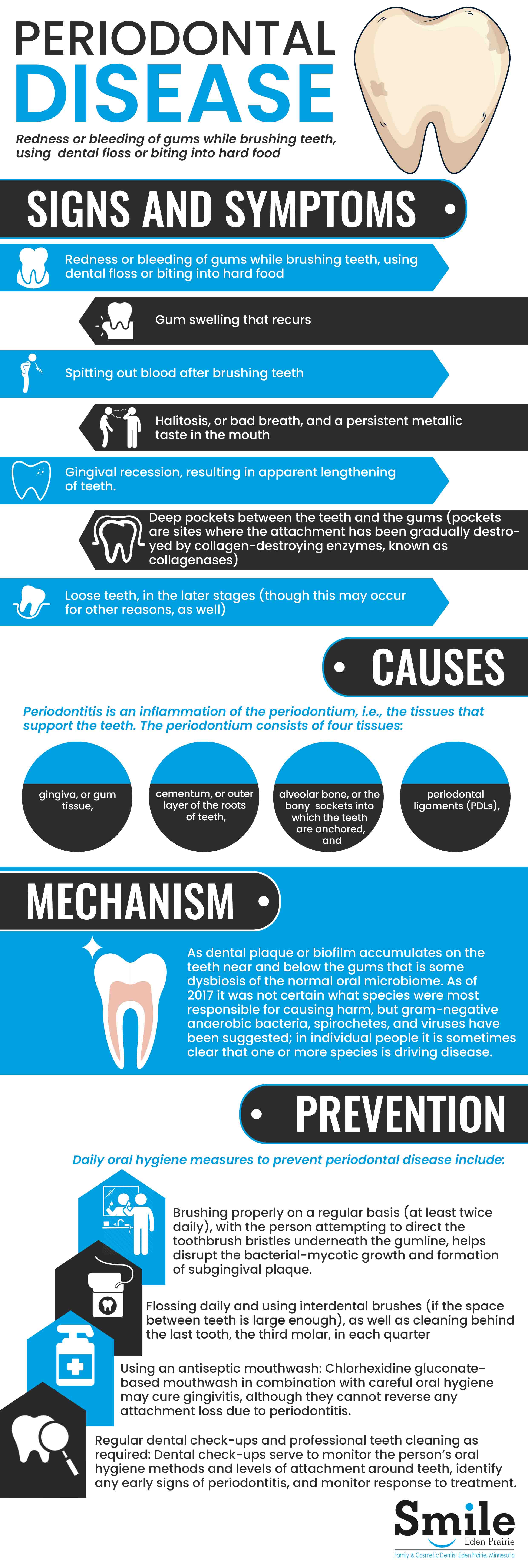General Dentistry Concepts: Periodontitis
Periodontal disease, which is also referred to as gum disease, involves inflammatory conditions that affect the tissues around the teeth. This is called gingivitis in its early stage. Gingivitis causes the gums to become swollen, red and can sometimes bleed. As it progresses to a more serious form, it is called periodontitis. Periodontitis can result in the gums pulling away from the tooth, bone loss and the teeth can become loose or even fall out. This can also cause bad breath.
Periodontal disease is usually a result of bacteria in the mouth which infects the tissue surrounding the teeth. Risk factors for the disease can include smoking, diabetes, HIV/AIDS, family history in addition to certain medications. Diagnosis involves inspecting the gum tissue around the teeth visually or by using a probe and X-rays which evaluate bone loss around the teeth.
Treatment for the disease includes practicing good oral hygiene and regular professional teeth cleaning. The recommended oral hygiene routine includes twice daily brushing and regular flossing. In some cases, antibiotics or dental surgery may be required for treatment. Approximately 538 million people are affected by the disease globally. In the United States, nearly half of patients over the age of 30 are affected and nearly 70% of patients over the age of 65 have the condition. The disease affects males more often than females.
Signs and symptoms
Periodontitis does not have many symptoms in the early stages. For many patients, the disease significantly progresses before they seek treatment.
Symptoms may include the following:
- Redness or bleeding of gums while brushing teeth, using dental floss or biting into food
- Reoccurring gum swelling
- Bad breath or halitosis and a metallic taste in the mouth
- Gingival recession, resulting in the appearance of longer teeth
- Deep pockets between the teeth and the gums
- Loose teeth, which often occurs in the later stages of the disease
People should be aware that gingival inflammation and bone destruction don’t always result in pain. People often assume that painless bleeding following teeth cleaning is insignificant. Though it may actually be a symptom of periodontitis.
Associated conditions
Periodontitis is associated with a higher risk of stroke, myocardial infarction, atherosclerosis and hypertension. It has also been linked in those over 60 years of age to the impairments in delayed memory and calculation abilities. Individuals with impaired fasting glucose and diabetes mellitus have been found to have higher degrees of periodontal inflammation. The also often have difficulty in balancing their blood glucose level due to the constant systemic inflammatory state which is caused by the periodontal inflammation. Although there is no proven causal association, there is an association between chronic periodontitis and erectile dysfunction, heart disease and pancreatic cancer.
Causes
Periodontitis is an inflammation of the periodontium or tissues which support the teeth. The periodontium consists of four different tissues:
- Gingiva: gum tissue
- Cementum: outer layer of the roots of teeth
- Alveolar bone: the bony sockets into which the teeth are anchored
- Periodontal ligaments (PDLs): the connective tissue fibers that run between the cementum and the alveolar bone
The primary cause of gingivitis is a result of poor or ineffective oral hygiene. This leads to the accumulation of plaque at the gum line. Other contributing factors include poor nutrition and underlying medical issues like diabetes. People with diabetes must be meticulous with their oral care at home in order to control and prevent periodontal disease.

